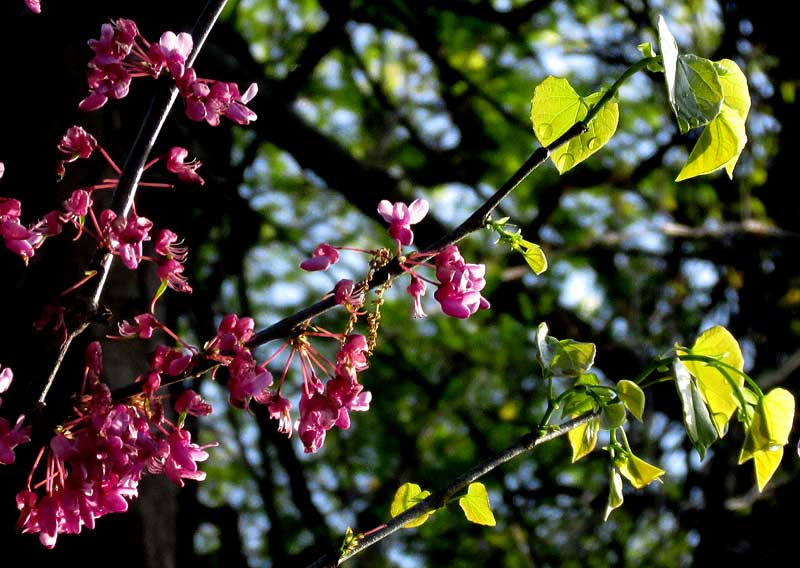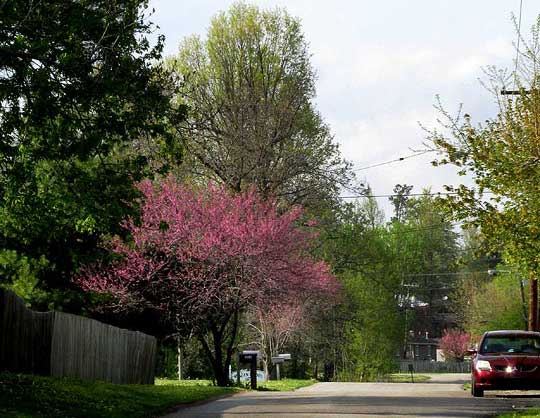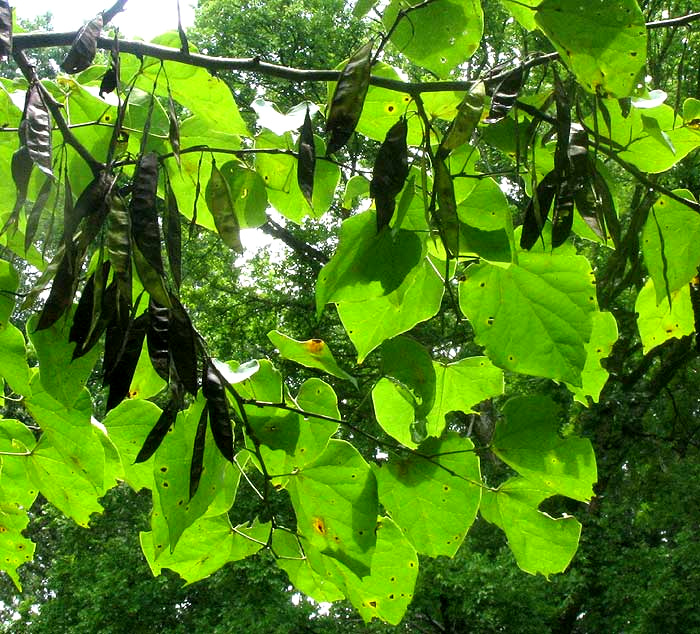Excerpts from Jim Conrad's
Naturalist Newsletter

from the the April 19, 2015 Newsletter, issued from Calhoun, McLean County, Kentucky, USA
REDBUDS AT THEIR FLOWERING PEAK
My week-long visit with my aunt in western Kentucky happily coincides with the absolute peak of flowering of the Eastern Redbud. All through town, as leaves unfurl from buds on trees and dandelions adorn dazzlingly green lawns, the Redbuds add grace and loveliness everywhere. Redbuds are native trees here, often found in local woods, so most, if not nearly all, of the town's Redbuds have been transplanted from the woods. Below, you can see a typical, Redbud-enhaced view of a usually uninspiring street near my aunt's house:

Most people seldom look closely at Redbud flowers, but those are worthy of admiration, too, as you can see at the top of this page.
Up closer still, individual Redbud blossoms reveal themselves as "papilionaceous" flowers typical of the Bean Family. A normal papilionaceous blossom bears five petals. The topmost petal -- often called the "standard" -- usually is the largest, then there are two "wings," or side petals, and then the two lowest petals are fused along their common side, forming a scoop-shaped "keel" inside which are held ten stamens with their filaments united into a cylinder surrounding the future legume. Below, you can see the Redbud's papilionaceous flower -- and notice that it departs a little from the papilionaceous blossom's standard formula:

Here's what's unusual about the Redbud's papilionaceous flower: It seems to lack the topmost petal, the standard, and normally that's the largest and most conspicuous of the five petals. Actually, the Redbud flower's standard is present, but it's very small and held beneath the other petals, and it isn't visible in our picture. Redbud flowers also are somewhat unusual for being bean flowers because they're so brightly pink colored, though you might remember that during our travels we've run into red-flowered bean vines.
I'll always remember this visit with family in Kentucky as "the visit of the Redbud's blossoming," and I can think of no more appealing association than that.

from the July 15, 2012 Newsletter issued from the woods of the Loess Hill Region a few miles east of Natchez, Mississippi, USA
REDBUDS FRUITING
Eastern Redbuds, CERCIS CANADENSIS, get plenty of press when the smallish but elegantly formed and leafless trees blossom so prettily in spring, but nowadays I'm enjoying seeing their abundant, black fruits dangling from the trees' sun-glowing, heart-shaped leaves, as seen above.
Redbuds are members of the Bean Family, so the fruits are legumes and the hard, black seeds inside them are beans. The legumes hang on the branches for a long time, sometimes through most of winter. During that time the pods' sutures split or the walls simply rot away, enabling the seeds to escape. On windy fall or early-winter days when the fruits flap wildly in the breezes, some seeds get thrown fair distances from their trees. Other fruits fall off and are blown even farther, with seeds still inside them. It's a sloppy, hit-or-miss seed dispersal strategy and that may explain why so many pods are produced, in the "hopes" that at least one or two beans among thousands will land someplace useful.
Redbud seeds have hard seed-coats, so the seeds need certain things to happen to them before they germinate. In nature germination is enhanced by fire, digestion by a bird or mammal, or partial breakdown of the seed coat by fungi or insects. Further, growth-inhibiting substances are present in the seed coat, the interior of the seed, and tissue surrounding it. Artificial breaking of the seeds' dormancy can be brought about by a 30-minute soak in sulfuric acid followed by a period of cold to break embryo dormancy.
Redbuds are mostly understory trees liking rich, moist soil, though often you see them invading abandoned farmlands. They're common throughout the eastern US, except for the northern states, and along the Gulf Coast. In southern Texas and much of northeastern Mexico there's an outlying population.